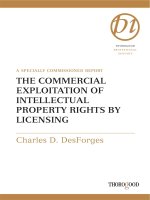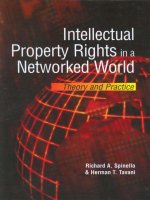- Trang chủ >>
- Thạc sĩ - Cao học >>
- Luật
Ebook Antitrust law and intellectual property rights: Part 1
Bạn đang xem bản rút gọn của tài liệu. Xem và tải ngay bản đầy đủ của tài liệu tại đây (1.27 MB, 407 trang )
Antitrust Law and
Intellectual Property
Rights
This page intentionally left blank
Antitrust Law and
Intellectual Property
Rights
CASES AND MATERIALS
CHRISTOPHER R. LESLIE
1
1
Oxford University Press, Inc., publishes works that further Oxford University’s objective
of excellence in research, scholarship, and education.
Oxford New York
Auckland Cape Town Dar es Salaam Hong Kong Karachi Kuala Lumpur
Mexico City Nairobi New Delhi Shanghai Taipei Toronto
Madrid
Melbourne
With offices in
Argentina Austria Brazil Chile Czech Republic France Greece Guatemala Hungary Italy
Japan Poland Portugal Singapore South Korea Switzerland Thailand Turkey Ukraine
Vietnam
Copyright © 2011 by Oxford University Press, Inc.
Published by Oxford University Press, Inc.
198 Madison Avenue, New York, New York 10016
Oxford is a registered trademark of Oxford University Press
Oxford University Press is a registered trademark of Oxford University Press, Inc.
All rights reserved. No part of this publication may be reproduced, stored in a retrieval system, or transmitted, in any
form or by any means, electronic, mechanical, photocopying, recording, or otherwise, without the prior permission
of Oxford University Press, Inc.
______________________________________________
Library of Congress Cataloging-in-Publication Data
Leslie, Christopher R.
Antitrust law and intellectual property rights : cases and materials / Christopher R. Leslie.
p. cm.
Includes bibliographical references and index.
ISBN 978-0-19-533719-8 ((hardback) : alk. paper)
1. Intellectual property—United States. 2. Antitrust law—United States. I. Title.
KF3116.L47 2010
346.7304'8—dc22
2010020812
______________________________________________
1 2 3 4 5 6 7 8 9
Printed in the United States of America on acid-free paper
Note to Readers
This publication is designed to provide accurate and authoritative information in regard to the subject matter covered. It is
based upon sources believed to be accurate and reliable and is intended to be current as of the time it was written. It is sold
with the understanding that the publisher is not engaged in rendering legal, accounting, or other professional services. If legal
advice or other expert assistance is required, the services of a competent professional person should be sought. Also, to confirm
that the information has not been affected or changed by recent developments, traditional legal research techniques should be
used, including checking primary sources where appropriate.
(Based on the Declaration of Principles jointly adopted by a Committee of the
American Bar Association and a Committee of Publishers and Associations.)
You may order this or any other Oxford University Press publication by
visiting the Oxford University Press website at www.oup.com
For Tony
This page intentionally left blank
CONTENTS
Preface and Acknowledgments
xix
part one:
the foundations of the intersection between
antitrust law and intellectual property rights
1
2
1
A Primer on Intellectual Property Law
3
A. Patents
5
B. Copyrights
11
C. Trademarks
14
D. Trade Secrets
18
E. Other Forms of Intellectual Property
19
Comments and Questions
19
Bibliography of Additional Resources
21
A Primer on Antitrust Law
23
A. Sherman Act (1890)
25
Section One of the Sherman Act
25
Section Two of the Sherman Act
Monopolization
27
28
vii
viii Contents
Attempted Monopolization
Conspiracies to Monopolize
B. Clayton Act (1914)
33
Tying Arrangements
33
Mergers
34
Other Aspects of the Clayton Act
35
C. Federal Trade Commission Act (1914)
35
Remedies
3
31
32
35
Comments and Questions
36
Bibliography of Additional Resources
37
The Tension Between Antitrust and Intellectual
Property
39
A. A Brief History on the Relationship Between Antitrust
Law and Intellectual Property Rights
39
Atari Games Corp. v. Nintendo of America, Inc.
44
Comments and Questions
46
B. The Relationship Between Intellectual Property
and Market Power
46
DOJ-FTC Antitrust Guidelines for the Licensing of
Intellectual Property, Sec. 2.2
47
Illinois Tool Works v. Independent Ink, Inc.
47
Comments and Questions
54
Bibliography of Additional Resources
56
C. Antitrust Law and the Misuse of Intellectual Property
56
1. Patent Misuse
County Materials Corp. v. Allan Block Corp.
Comments and Questions
57
57
60
2. Copyright Misuse
Lasercomb America, Inc. v. Reynolds
Comments and Questions
61
61
64
3. Trademark Misuse
66
Bibliography of Additional Resources
67
Contents ix
D. Economic Concepts
1. Price Discrimination
Note on the Robinson-Patman Act
Comments and Questions
68
70
71
2. Efficiency
Thomas O. Barnett, Interoperability Between
Antitrust and Intellectual Property
Comments and Questions
72
3. Networks Effects
U.S. v. Microsoft Corp.
Comments and Questions
73
73
83
Bibliography of Additional Resources
84
part two:
the antitrust implications of unilateral
conduct by intellectual property owners
4
68
72
73
87
Enforcement of Intellectual Property Rights
89
A. Enforcement of a Fraudulently Procured Patent
89
Walker Process Equipment v. Food
Machinery & Chemical Corp.
Comments and Questions
89
92
Dippin’ Dots, Inc. v. Mosey
Comments and Questions
94
99
Brunswick Corp. v. Riegel Textile Corp.
Comments and Questions
100
103
Bibliography of Additional Resources
104
B. Sham Litigation
104
CVD, Inc. v. Raytheon Co.
Comments and Questions
104
110
Note on the Noerr-Pennington Doctrine
111
Professional Real Estate Investors v. Columbia
Pictures
Comments and Questions
113
118
Note on Filmtec Corp. v. Hydranautics
120
x Contents
5
Primetime 24 Joint Venture v. National Broadcasting Co.
Comments and Questions
123
128
Bibliography of Additional Resources
129
Tying Arrangements and Intellectual Property
U.S. Dep’t of Justice & Federal Trade Commission, Antitrust
Enforcement and Intellectual Property Rights: Promoting
Innovation and Competition (2007)
131
DOJ-FTC Antitrust Guidelines for the Licensing
of Intellectual Property, Sec. 5.3
131
A. Tying Arrangements and Patented Products
132
International Salt Co. v. United States
Comments and Questions
132
135
B. Antitrust Implications of Block-Booking
of Copyrighted Works
139
United States v. Paramount Pictures, Inc.
Comments and Questions
139
140
United States v. Loew’s, Inc.
Comments and Questions
141
145
Outlet Communications, Inc. v. King
World Productions, Inc.
Comments and Questions
147
149
C. Copyrighted Software and Tying
Digidyne Corp. v. Data General Corp.
Comments and Questions
D. Trademarks and Tying
6
131
149
149
153
154
Siegel v. Chicken Delight, Inc.
Comments and Questions
154
157
Krehl v. Baskin-Robbins Ice Cream Co.
Comments and Questions
158
162
Tominaga v. Shepherd
Comments and Questions
162
165
Bibliography of Additional Resources
165
Unilateral Refusals to License or Deal
DOJ-FTC Antitrust Guidelines for the Licensing of Intellectual
Property, Sec. 2.2
167
167
Contents xi
Data General Corp. v. Grumman Systems Support Corp.
Comments and Questions
Image Technical Serv. v. Eastman Kodak
Comments and Questions
In re Independent Service Organizations
Antitrust Litigation (Xerox)
Comments and Questions
178
189
190
195
199
Note on the Digital Millennium Copyright Act
200
Intergraph Corp. v. Intel Corp.
203
Comments and Questions
212
Design Changes and Predatory Innovation
Berkey Photo, Inc. v. Eastman Kodak Co.
Comments and Questions
Foremost Pro Color, Inc. v. Eastman Kodak Co.
213
215
215
227
231
Comments and Questions
235
C.R. Bard, Inc. v. M3 Systems, Inc.
236
Comments and Questions
240
Automatic Radio Manufacturing Co. v. Ford Motor Co.
Comments and Questions
Abbott Laboratories v. Teva Pharmaceuticals USA, Inc.
Comments and Questions
Bibliography of Additional Resources
8
176
Note on Market Power in Aftermarkets
Bibliography of Additional Resources
7
167
Deceptive Conduct before Standard-Setting
Organizations
In the Matter of Dell Computer Corp.
243
245
245
253
255
257
257
Comments and Questions
261
Broadcom Corp. v. Qualcomm Inc.
262
Comments and Questions
273
Rambus, Inc. v. FTC
Comments and Questions
274
282
xii Contents
Note on Section 5 of the Federal Trade Commission Act
284
Bibliography of Additional Resources
287
part three:
the antitrust implications of horizontal
agreements involving intellectual property
9
Price Fixing and Intellectual Property
A. Patents and Cartels
289
291
291
United States v. United States Gypsum Co.
Comments and Questions
291
298
Addamax Corp. v. Open Software Foundation, Inc.
Comments and Questions
300
305
B. Patent Pooling and Price Fixing
305
DOJ-FTC Antitrust Guidelines for the Licensing of
Intellectual Property, § 5.5 Cross-licensing and pooling
arrangements
305
Standard Oil Co. v. United States
Comments and Questions
307
311
Matsushita Electrical Industrial Co. v. Cinram
Comments and Questions
316
321
Federal Trade Commission In the Matter
of Summit Technology
Comments and Questions
323
327
C. Blanket Licensing of Copyrighted Works
327
Broadcast Music, Inc. v. CBS
Comments and Questions
327
336
Note on Agreements to Fix a Maximum Price
338
D. Standard-setting Organizations
339
U.S. Dep’t of Justice & Federal Trade Commission, Antitrust
Enforcement and Intellectual Property Rights:
Promoting Innovation and Competition (2007)
340
Sony Electronics, Inc. v. Soundview Technologies, Inc.
Comments and Questions
340
345
Bibliography of Additional Resources
349
Contents xiii
10
Market Allocation and Intellectual
Property Rights
A. Patents and Market Allocation
Hartford-Empire Co. v. United States
Comments and Questions
B. Trademarks and Market Allocation
351
351
355
355
Timken Roller Bearing Co. v. United States
Comments and Questions
355
356
United States v. Sealy
Comments and Questions
357
362
United States v. Topco Associates, Inc.
Comments and Questions
362
369
Palmer v. BRG of Georgia, Inc.
Comments and Questions
369
371
Clorox Co. v. Sterling Winthrop, Inc.
Comments and Questions
371
377
C. Copyrights and Market Allocation
Auwood v. Harry Brandt Booking Office, Inc.
Comments and Questions
378
378
380
D. International Intellectual Property Regimes
and Market Allocation
381
Metro Industries, Inc. v. Sammi Corp.
Comments and Questions
381
385
E. DOJ-FTC Antitrust Guidelines for the Licensing of
Intellectual Property, Sec. 5.1
11
351
Pharmaceutical Settlements and
Reverse Payments
In re Cardizem CD Antitrust Litigation
Comments and Questions
Schering-Plough Corp. v. F.T.C.
Comments and Questions
C. Scott Hemphill, An Aggregate Approach to Antitrust:
Using New Data and Rulemaking to Preserve Drug
Competition, 109 COLUMBIA LAW REVIEW 629 (2009)
385
387
387
393
394
410
412
xiv Contents
In re Tamoxifen Citrate Antitrust Litigation
Comments and Questions
Bibliography of Additional Resources
12
Agreements to Buy and Sell Intellectual
Property as an Antitrust Violation
A. Acquisition of IP as a Conspiracy to Restrain Trade
13
413
427
431
433
433
United States v. Singer Manufacturing, Co.
Comments and Questions
433
442
B. Agreements to Acquire Intellectual Property and
Merger Law
444
DOJ-FTC Antitrust Guidelines for the Licensing of
Intellectual Property § 5.7
444
Antitrust Modernization Commission: Report and
Recommendations (2007)
444
A Note on Technology and Innovation Markets
449
DOJ-FTC Antitrust Guidelines for the Licensing
of Intellectual Property §3.2
449
Federal Trade Commission In the Matter
of Ciba-Geigy Ltd.
Comments and Questions
450
458
Group Boycotts and Concerted Refusals to
Deal or License
459
A. Antitrust Treatment of Concerted Refusals to Deal
459
Fashion Originators Guild of America v. Federal Trade
Commission
Comments and Questions
B. Concerted Refusals to Deal with a Patentee
Jones Knitting Corp. v. Morgan
Comments and Questions
C. Group Boycotts and Copyrights
459
462
462
462
465
465
Primetime 24 Joint Venture v. National Broadcasting Co.
Comments and Questions
465
467
The Movie 1 & 2 v. United Artists Communications, Inc.
Comments and Questions
468
472
Contents xv
part four:
the antitrust implications of vertical
agreements involving intellectual property
14
Vertical Price Restraints and
Intellectual Property
475
A. The Foundation of Antitrust’s Treatment of Vertical
Price Restraints
475
Dr. Miles Medical Co. v. John D. Park & Sons Co.
Comments and Questions
B. General Electric and the Ability of Patent Owners
to Set Resale Prices
United States v. Line Materials Co.
Comments and Questions
C. Vertical Price Fixing and Copyrighted Works
475
479
480
480
486
489
United States v. Paramount Pictures, Inc.
Comments and Questions
489
491
LucasArts Entertainment Co. v. Humongous
Entertainment Co.
Comments and Questions
492
495
A Note on the First Sale Doctrine
495
D. Resale Price Maintenance and Trademarked Goods
496
U.S. v. Frankfort Distilleries
496
Hudson Distributors, Inc. v. Eli Lilly & Co.
Comments and Questions
497
500
E. The Demise of Dr. Miles
Leegin Creative Leather Products, Inc. v. PSKS, Inc.
Comments and Questions
15
473
Non-price Licensing Restrictions
500
500
509
511
DOJ-FTC Antitrust Guidelines for the Licensing
of Intellectual Property, § 2.3
511
B. Braun Med., Inc. v. Abbott Labs
512
Comments and Questions
515
A Note on Exhaustion Doctrine
515
xvi Contents
United States v. Studiengesellschaft Kohle
Comments and Questions
527
Transparent-Wrap Machine Corp. v. Stokes & Smith Co.
528
531
Bibliography of Additional Resources
534
The Antitrust Implications of
Structuring Royalties
535
Automatic Radio Manufacturing v. Hazeltine Research
Comments and Questions
Brulotte v. Thys Co.
Comments and Questions
Zenith Radio Corp. v. Hazeltine Research, Inc.
535
538
539
541
543
Comments and Questions
548
Scheiber v. Dolby Laboratories, Inc.
549
Comments and Questions
552
Bibliography of Additional Resources
part five:
injury, remedies, jurisdiction and
procedural issues
17
527
DOJ-FTC Antitrust Guidelines for the Licensing of Intellectual
Property, Examples of Licensing
Comments and Questions
16
517
Standing and Antitrust Injury
A. Competitor Standing
553
555
557
557
Handgards, Inc. v. Ethicon, Inc.
Comments and Questions
557
559
Bourns, Inc. v. Raychem Corp.
Comments and Questions
560
564
B. Consumer Standing
In re Ciprofloxacin Hydrochloride Antitrust Litigation
564
564
Contents xvii
Molecular Diagnostics Laboratories v. Hoffmann-La
Roche Inc.
Comments and Questions
Bibliography of Additional Resources
18
Remedies
U. S. v. Glaxo Group Ltd.
Comments and Questions
Bibliography of Additional Resources
19
Jurisdiction and Procedural Issues
565
567
567
569
569
573
576
577
Christianson v. Colt Industries Operating Corp.
578
Holmes Group, Inc. v. Vornado Air Circulation Systems, Inc.
583
Comments and Questions
585
Hydranautics v. FilmTec Corp.
586
Comments and Questions
587
Bibliography of Additional Resources
appendices
588
589
Appendix A: Statutory Supplement
591
Appendix B: Antitrust Guidelines for the Licensing of
Intellectual Property
617
Appendix C: Microeconomic Analysis and Graphs
647
Table of Cases
Index
659
669
This page intentionally left blank
PREFACE AND ACKNOWLEDGMENTS
Typically, courses in intellectual property law focus primarily on the philosophy behind protecting intellectual property rights, how to secure and enforce the
rights, and the scope of such intellectual property rights. Patents, copyrights, and
trademarks are characterized by the range of exclusionary rights associated with
each body of law. Intellectual property rights can, in some circumstances, confer considerable market power upon their owners. Such firms sometimes exercise
this power in ways that exceed the legitimate bounds of their intellectual property
rights. While substantive IP law defines the scope of the exclusionary rights, it is
antitrust law that often provides the most important consequences when IP owners inappropriately exercise their rights in a way that harms consumers or illegitimately excludes competitors. Antitrust law defines the limits of what intellectual
property owners can do with their IP rights.
This book’s primary focus is doctrinal antitrust law, as applied to issues involving intellectual property rights. Aside from the introductory primer on intellectual
property rights in the first chapter, the book does not concentrate on substantive
intellectual property law. Instead it focuses on what conduct firms can and cannot
engage in while acquiring and exploiting their intellectual property rights. This
casebook explores those aspects of antitrust law that are necessary for both antitrust practitioners and intellectual property attorneys, involved in either litigation
or transactions, to understand.
This book is the culmination of a decade of work and the input of many talented colleagues and students. I have taught my course on Antitrust Law and Intellectual Property Rights at New York University School of Law, University of Texas
School of Law, the University of Illinois College of Law, and my former home
institution, the Chicago-Kent College of Law. My interactions with the students
helped considerably in developing this casebook. Several students—Inya Baiye,
xix
xx Preface and Acknowledgements
Karin Hessler, Ben Kleinman, and Kate Stutt—provided line edits and other useful
suggestions.
I owe special thanks to three of my former students from New York University
School of Law—Jason Adler, Cedric Logan, and Jonathan Salzberger. I had the
pleasure of teaching them in my seminar Antitrust Law and Intellectual Property
Rights, after which each of them helped research and write some of the Comments
and Questions following the case excerpts.
Several law professors provided invaluable feedback and suggestions after either
teaching from a draft version of the book or reviewing a draft manuscript. These
included Tom Cotter, Dan Crane, Carol Handler, Mark Lemley, Barak Orbach,
and Tony Reese. The book is much improved because of their input.
My faculty assistant, Lisa Payne, provided excellent assistance in making the
graphs in the Economics Appendix.
Finally, this casebook would not exist but for the hard work of Lori Wood
who shepherded the proposal through Oxford University Press and provided both
guidance and encouragement.
Christopher R. Leslie
Irvine, California
PART ONE
the foundations of the
intersection between
antitrust law and intellectual
property rights
This page intentionally left blank
CHAPTER 1
A Primer on Intellectual
Property Law
In many ways, property rights provide one of the critical foundations of modern
capitalist society. Free market economies assume the ownership of real estate and
moveable objects that can be voluntarily traded for the mutual gain of both buyers
and sellers. Capitalism could not exist without property rights.
Intellectual property (IP) refers to “[a] category of intangible rights protecting
commercially valuable products of the human intellect. The category comprises
primarily trademark, copyright, and patent rights, but also includes trade-secret
rights, publicity rights, moral rights, and rights against unfair competition.”1 The
fact that intellectual property is intangible distinguishes it from physical property.
The consumption of physical goods is generally rivalrous. One person’s consumption of a physical good depletes the supply for others. For example, two people
cannot each eat the entirety of the same apple. In addition, physical property is
generally appropriable. The owner of physical property can exclude others from
using the property by securing it (in the case of goods or chattels) or by preventing
trespass (in the case of land or other real estate) by, for example, building walls.
In contrast, the consumption of the subjects of intellectual property is generally nonrivalrous because one person’s use of an invention does not diminish
another person’s ability to exploit that invention by making a copy. The nonrivalrous aspect of intellectual property has both positive and negative attributes. On
the positive side, sharing and distribution often entails a relatively low cost. Once
a disease-curing drug has been invented, it can be manufactured at a low cost and
made affordable to low-income individuals afflicted with the particular disease.
One person’s enjoyment of a work of authorship, such as a song, does not prevent
1
Black’s Law Dictionary (8th ed. 2004).
3
4 Antitrust Law and Intellectual Property Rights
other people from also enjoying that same song. In addition, it is usually difficult
for inventors and authors to exclude other people from the benefits of their creations, at least if the creators want to exploit their economic value, which generally requires disclosing the creations to the public. Once an invention or work of
authorship is disclosed, it can be difficult to keep others from copying it.
The difficulty of excluding others from the economic benefits of intellectual
creations has a negative side. Invention generally requires a significant investment
of time and labor. New products and ideas often result from an arduous process of
trial and error—combined with both ingenuity and luck. In contrast, conversion
is substantially quicker than creation. Reverse engineering—the process of taking a
product apart to see how it is built in order to reconstruct one’s own version of the
product—is often cheaper than invention from scratch. Similarly, writing a novel
often takes years; copying it may take minutes. The copier can generally undersell
the innovator because the copier does not have to recoup the costs of creating and
developing the work and instead bears only the cost of producing the copies (costs
that the original creator also faces in producing her own copies for sale). In many
instances, products that are protected by intellectual property have relatively high
fixed costs (the cost of creation) but have relatively low marginal costs (the cost of
manufacturing each additional unit of output of a patented invention or a printed
volume of copyrighted work). This makes copying an attractive competitive strategy because the copier incurs none of the high fixed costs of creation and, thus, can
sell the product at a relatively low price.
However, if one’s ideas or inventions can be readily misappropriated by others,
then a creator has less incentive to invest in creating new products or authoring
new works. Firms and individuals would be less willing to invest their resources
into research and development if they feared the result of their efforts could be
appropriated by their competitors, who could undersell them since the copier has
fewer costs to recoup. If competitors in a particular market all wait for their rivals
to do the heavy lifting of creation, no firm would engage in meaningful research
and development. All firms and consumers would be worse off. Similarly, many
artists—be they writers, painters, choreographers, or moviemakers—would be less
likely to invest their time and energy creating works of authorship—and many
commercial entities would be less likely to invest in the dissemination of such
works—if they suspected their efforts could be readily copied.
Intellectual property law attempts to solve this problem by granting exclusionary rights to inventors and authors. Protecting physical property is relatively
straightforward. Moveable objects can be put under lock and key, while real estate
(and large immovable objects) can be fenced off. (Of course, some forms of physical property may be difficult to protect against trespass, such as vast tracts of land
in remote locations.) If physical barriers fail, property owners can sue for trespass
or conversion.
Physical exclusion is trickier with intellectual creations. Once an idea or artistic
work becomes public, it can be hard for an inventor to exclude others from using or
copying it. Intellectual property law addresses this problem by affording IP owners









